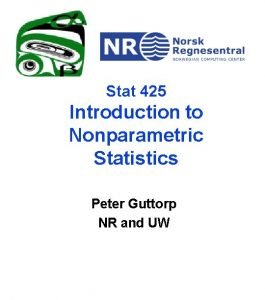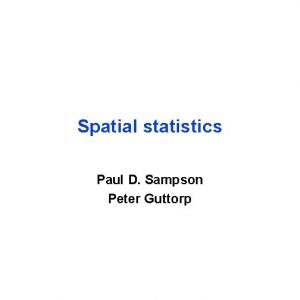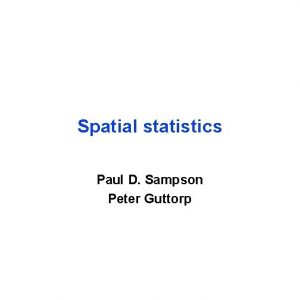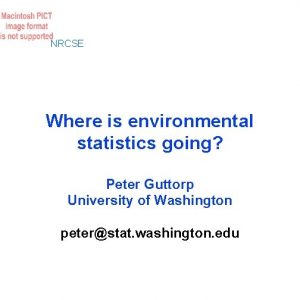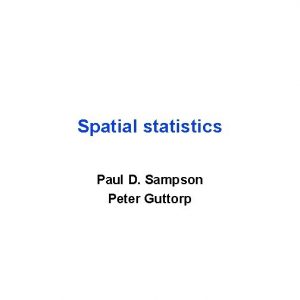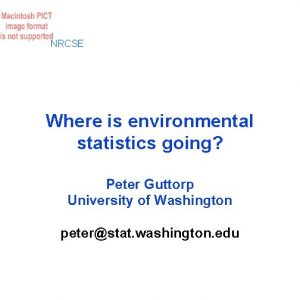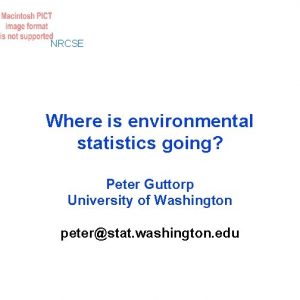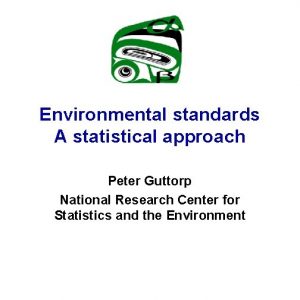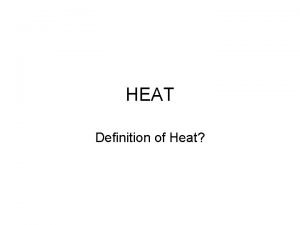The heat is on Peter Guttorp peter guttorpnr






































- Slides: 38

The heat is on! Peter Guttorp peter. guttorp@nr. no guttorp@uw. edu http: //www. stat. washington. edu/peter

The greenhouse effect Heat comes in from the sun Shortwave radiation Earth gets warmed up by the heat Earth radiates heat back Longwave radiation Greenhouse gases absorb much energy in radiating heat Atmosphere warms (15°C instead of -18°C) Main greenhouse gases: Water vapor Carbon dioxide Methane

The greenhouse effect Joseph Fourier (1768 -1830) realized that Earth ought to be a lot cooler than it is. John Tyndall (1820 -1893) found that water vapor and CO 2 are greenhouse gases Svante Arrhenius (1859 -1927) calculated how changes in CO 2 can heat the planet

What is climate? Climate is what you expect; weather is what you get. Heinlein: Notebooks of Lazarus Long (1978)

Outline Measurements Models Local impact Projections

Measurements

Measuring global surface temperature

Homogenization summertime correction miscalibrated thermometer screen painted white? urbanization

Global temperature measurements Marine data

Comparison between estimates

Is there a trend? An Ac t of Dog Global temperature

Models

Climate modeling

The issue of gridding Hurricanes Clouds Glaciers

Comparing global climate models to data

30 -year distributions

Local impact

Comparing climate model output to weather data Global models are very coarse Regional models are driven by boundary conditions given by global model runs In either case, describes distribution of weather, not actual weather Consider a regional model driven by “actual weather” Stockholm 50 km x 50 km grid, 3 hr resolution (SMHI-RCA 3; ERA 40)

Stockholm data issues Location was moved twice (1875, 1960) Calibration (1826: 0 reads as +0. 75; 1858, 1915; annual thereafter)

How well does the climate model reproduce data?

Model problem? Annual average temperature over the grid square containing the Stockholm site is about 1. 7°C warmer than the observed average Model calculates separately open air, forest, and water/ice. Do we need finer resolution?

Open air predictions Using 12. 5 km version of RCA 3, forced by ERA 40, looking at only open air predictions (77% of grid square is open air)

Is the station really in open air?

Comparison to forested model output

Projections

Why not predictions? Climate models need input of greenhouse gases, solar radiation, land use etc. To use climate models for prediction, must predict also these input variables. Instead, set up scenarios (reasonable values of the input variables). Run models with these inputs. We call that projections.

Projecting sea level rise Sea levels rise due to • warming of oceans • melting of land ice Most climate models do not output sea level Strategy: relate global mean temperature to global mean sea level relate global to local sea level Use projections of temperature to project local sea level

Bergen Cultural Heritage Site Storm surges up to 1. 4 m Land rise 2. 6 mm/year

Projections

Components of uncertainty

Using uncertainty in decision making Do Bergen authorities need to address sea level rise? If so, when? Adaptation costs: Outer barrier 30 B NOK (5 B CAD) Inner barriers 1. 1 B (0. 2 B) Need cumulative storm surge damage costs.

Current storm surge damage costs

Change due to sea level rise

Simulate damages Draw random annual cost Draw random increase factor path Draw random sea level path Accumulate costs over time Look at upper 95 th percentile of cumulative costs

When is an adaptation measure beneficial? Outer barrier Inner barriers

Some references P. Guttorp and J. Xiu (2011): Climate change, trends in extremes, and model assessment for a long temperature time series from Sweden. Environmetrics 22: 456 -463. P. F. Craigmile and P. Guttorp (2013): Can a regional climate model reproduce observed extreme temperatures? Statistica 73: 103 -122. P. Guttorp (2014): Statistics and Climate. Annual Reviews of Statistics and its Applications 1: 87 -101. P. Guttorp, D. Bolin, A. Januzzi, D. Jones, M. Novak, H. Podschwit, L. Richardson, A. Särkkä, C. Sowder and A Zimmerman (2014): Assessing the uncertainty in projecting local mean sea level from global temperature. Journal of Applied Meteorology and Climatology 53: 2163 -2170.


Uncertainty in cumulative damage
 Properties of heat
Properties of heat Latent heat and specific latent heat
Latent heat and specific latent heat Example of combination cooking method
Example of combination cooking method ưu thế lai là gì
ưu thế lai là gì Tư thế ngồi viết
Tư thế ngồi viết Thẻ vin
Thẻ vin Các môn thể thao bắt đầu bằng tiếng bóng
Các môn thể thao bắt đầu bằng tiếng bóng Hát kết hợp bộ gõ cơ thể
Hát kết hợp bộ gõ cơ thể Bàn tay mà dây bẩn
Bàn tay mà dây bẩn Mật thư anh em như thể tay chân
Mật thư anh em như thể tay chân Từ ngữ thể hiện lòng nhân hậu
Từ ngữ thể hiện lòng nhân hậu Trời xanh đây là của chúng ta thể thơ
Trời xanh đây là của chúng ta thể thơ Tư thế ngồi viết
Tư thế ngồi viết Thứ tự các dấu thăng giáng ở hóa biểu
Thứ tự các dấu thăng giáng ở hóa biểu Gấu đi như thế nào
Gấu đi như thế nào Thơ thất ngôn tứ tuyệt đường luật
Thơ thất ngôn tứ tuyệt đường luật Hổ sinh sản vào mùa nào
Hổ sinh sản vào mùa nào Thế nào là hệ số cao nhất
Thế nào là hệ số cao nhất Diễn thế sinh thái là
Diễn thế sinh thái là Vẽ hình chiếu vuông góc của vật thể sau
Vẽ hình chiếu vuông góc của vật thể sau Làm thế nào để 102-1=99
Làm thế nào để 102-1=99 Thế nào là mạng điện lắp đặt kiểu nổi
Thế nào là mạng điện lắp đặt kiểu nổi Lời thề hippocrates
Lời thề hippocrates Vẽ hình chiếu đứng bằng cạnh của vật thể
Vẽ hình chiếu đứng bằng cạnh của vật thể Chụp tư thế worms-breton
Chụp tư thế worms-breton đại từ thay thế
đại từ thay thế Quá trình desamine hóa có thể tạo ra
Quá trình desamine hóa có thể tạo ra Sự nuôi và dạy con của hổ
Sự nuôi và dạy con của hổ Các châu lục và đại dương trên thế giới
Các châu lục và đại dương trên thế giới Dot
Dot Bổ thể
Bổ thể Thế nào là sự mỏi cơ
Thế nào là sự mỏi cơ Phản ứng thế ankan
Phản ứng thế ankan Thiếu nhi thế giới liên hoan
Thiếu nhi thế giới liên hoan Phối cảnh
Phối cảnh Chúa yêu trần thế
Chúa yêu trần thế điện thế nghỉ
điện thế nghỉ Một số thể thơ truyền thống
Một số thể thơ truyền thống













































